文章目录
目录
一、标签语言特点:
形式:<开始标签 属性="属性值">标签体</结束标签>
分类:空标签 例:br、hr
UI标签 例:out标签
控制标签 例:if、foreach
数据标签 例:input、table
二、自定义标签
1)步骤
①助手类(继承BodyTagSupport)
源码:
package com.hemingxiang.tag;
import javax.servlet.jsp.JspException;
import javax.servlet.jsp.tagext.BodyTagSupport;
/**
* 助手类
* 必须继承bodytagSupport
* @author Administrator
*
*/
public class DemoTag1 extends BodyTagSupport{
@Override
public int doStartTag() throws JspException {
System.out.println("-------------开始标签-----------");
/*return super.doStartTag();*/
/*return SKIP_BODY;//有标签体下只执行两个方法*/
return EVAL_BODY_INCLUDE;
}
@Override
public int doAfterBody() throws JspException {
System.out.println("------------标签体--------------");
return super.doAfterBody();
/*return EVAL_BODY_AGAIN;*/
}
@Override
public int doEndTag() throws JspException {
System.out.println("------------结束标签-------------");
return super.doEndTag();
/*return SKIP_PAGE;*/
}
}
②标签库描述文件tld(tld文件必须保存到WEB-INF目录或其子目录)
<?xml version="1.0" encoding="UTF-8" ?>
<taglib xmlns="http://java.sun.com/xml/ns/j2ee"
xmlns:xsi="http://www.w3.org/2001/XMLSchema-instance"
xsi:schemaLocation="http://java.sun.com/xml/ns/j2ee http://java.sun.com/xml/ns/j2ee/web-jsptaglibrary_2_0.xsd"
version="2.0">
<description>JSTL 1.1 core library</description>
<display-name>JSTL core</display-name>
<tlib-version>1.1</tlib-version>
<short-name>x</short-name>
<uri>http://jsp.veryedu.cn</uri>
<validator>
<description>
Provides core validation features for JSTL tags.
</description>
<validator-class>
org.apache.taglibs.standard.tlv.JstlCoreTLV
</validator-class>
</validator>
<tag>
<!-- 代表标签库的名字 -->
<name>demo1</name>
<!-- 该标签对应的助手类 -->
<tag-class>com.hemingxiang.tag.DemoTag1</tag-class>
<!-- 代表是一个jsp标签 -->
<body-content>JSP</body-content>
<attribute>
<!-- 该自定义标签的属性名称 -->
<name>var</name>
<!-- 该属性是否必填 -->
<required>false</required>
<!-- 该属性值是否支持表达式 -->
<rtexprvalue>false</rtexprvalue>
</attribute>
</tag>
<tag>
<name>if</name>
<tag-class>com.hemingxiang.tag.IfTag</tag-class>
<body-content>JSP</body-content>
<attribute>
<name>test</name>
<required>true</required>
<rtexprvalue>true</rtexprvalue>
</attribute>
</tag>
<tag>
<name>set</name>
<tag-class>com.hemingxiang.tag.SetTag</tag-class>
<body-content>JSP</body-content>
<attribute>
<name>var</name>
<required>true</required>
<rtexprvalue>false</rtexprvalue>
</attribute>
<attribute>
<name>value</name>
<required>true</required>
<rtexprvalue>true</rtexprvalue>
</attribute>
</tag>
<tag>
<name>out</name>
<tag-class>com.hemingxiang.tag.OutTag</tag-class>
<body-content>JSP</body-content>
<attribute>
<name>value</name>
<required>true</required>
<rtexprvalue>true</rtexprvalue>
</attribute>
</tag>
</taglib>
③JSP通过taglib指令导入标签库

2)实例
先创建一个tld文件: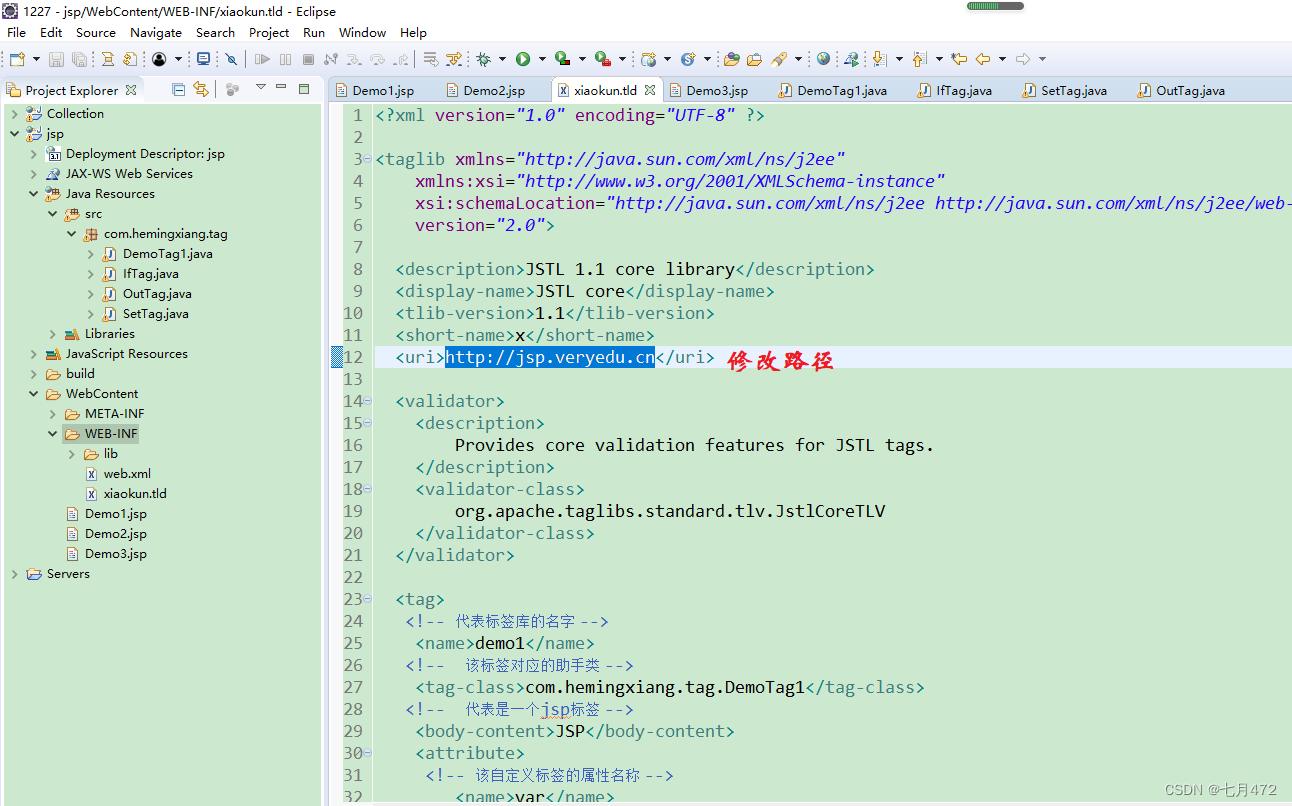
再创建一个助手类:

 在有标签体的情况下,默认会调用助手类的doStartTag,doAfterBody,doEndTag方法
在有标签体的情况下,默认会调用助手类的doStartTag,doAfterBody,doEndTag方法
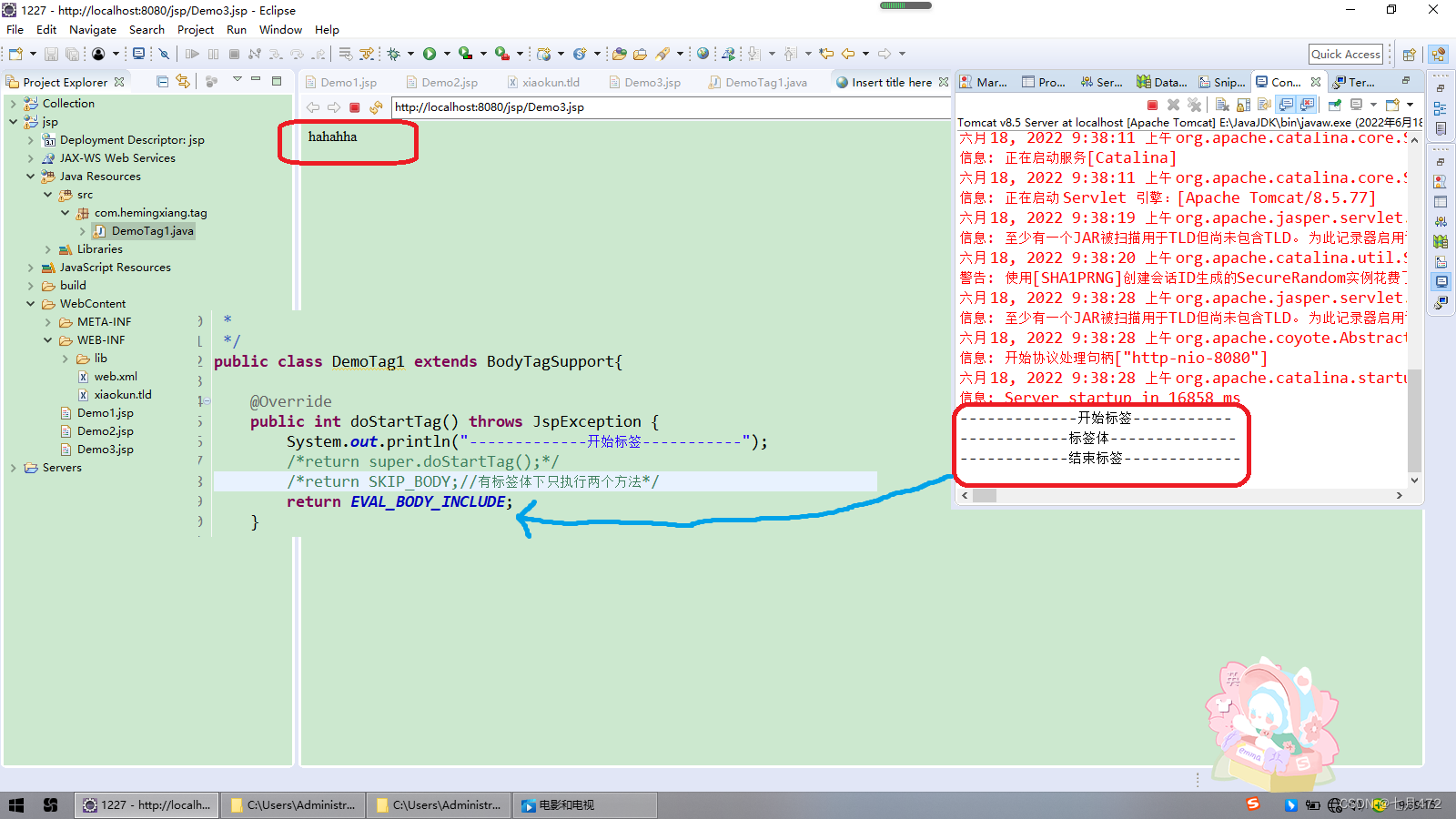
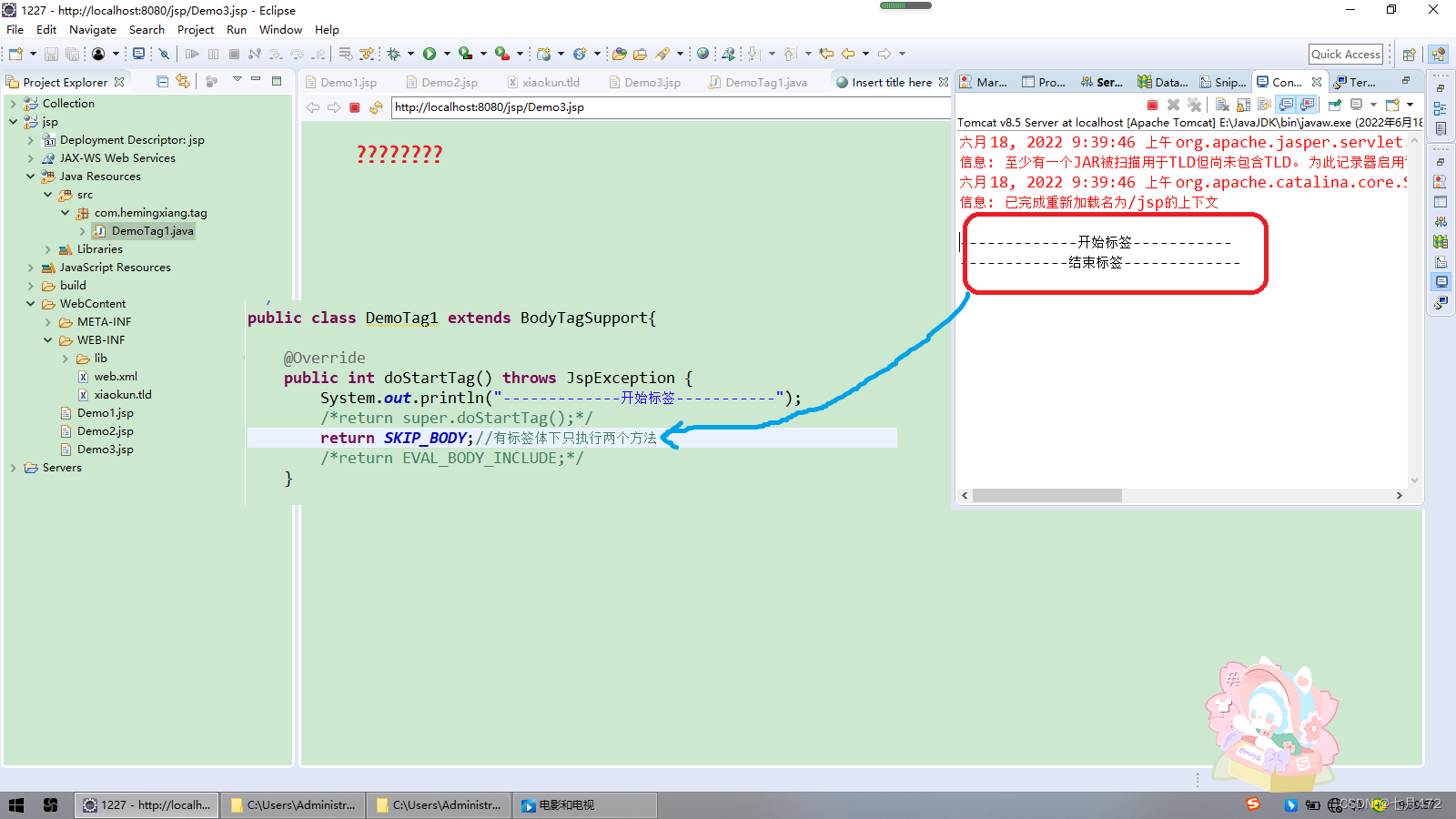
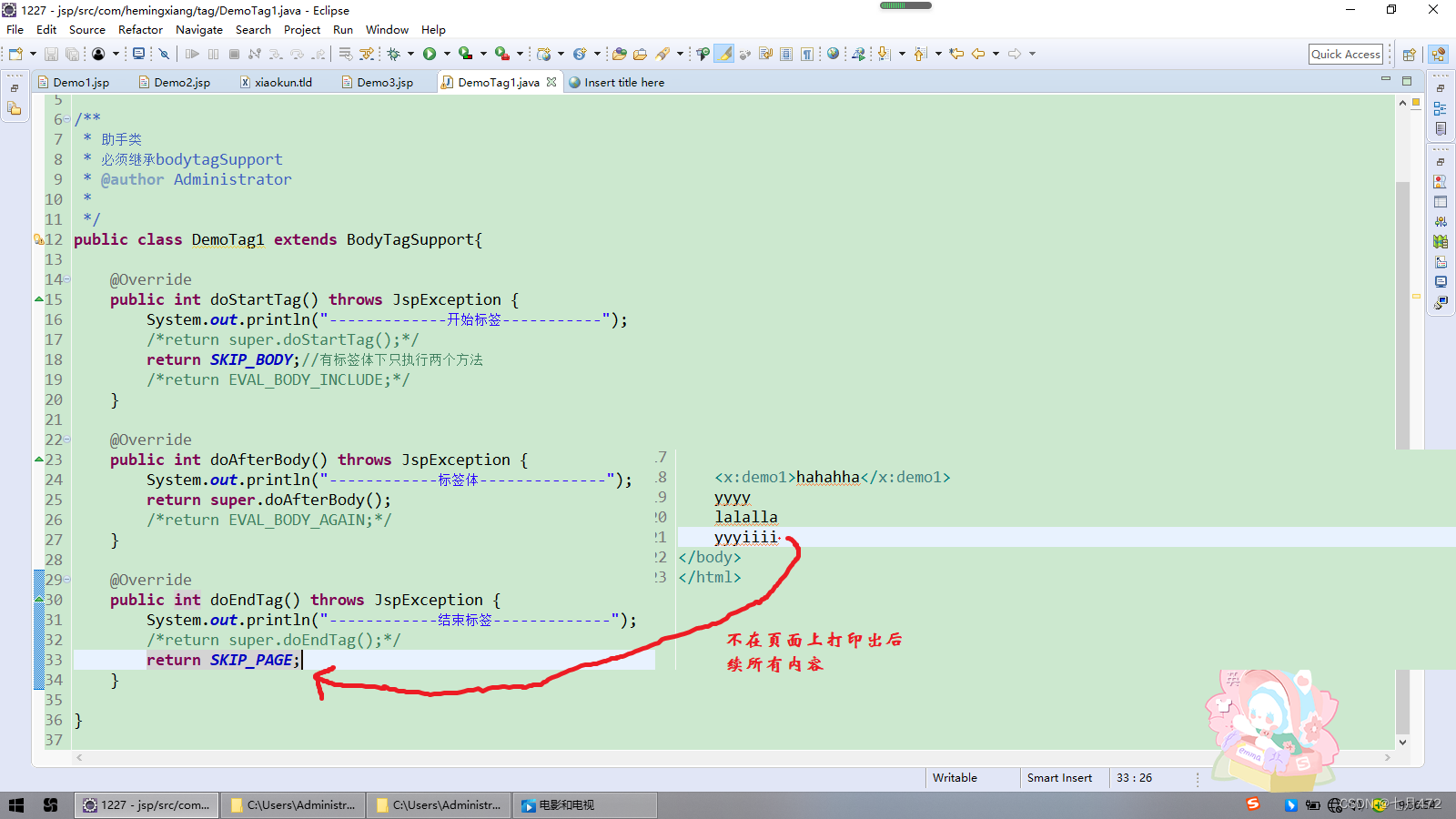
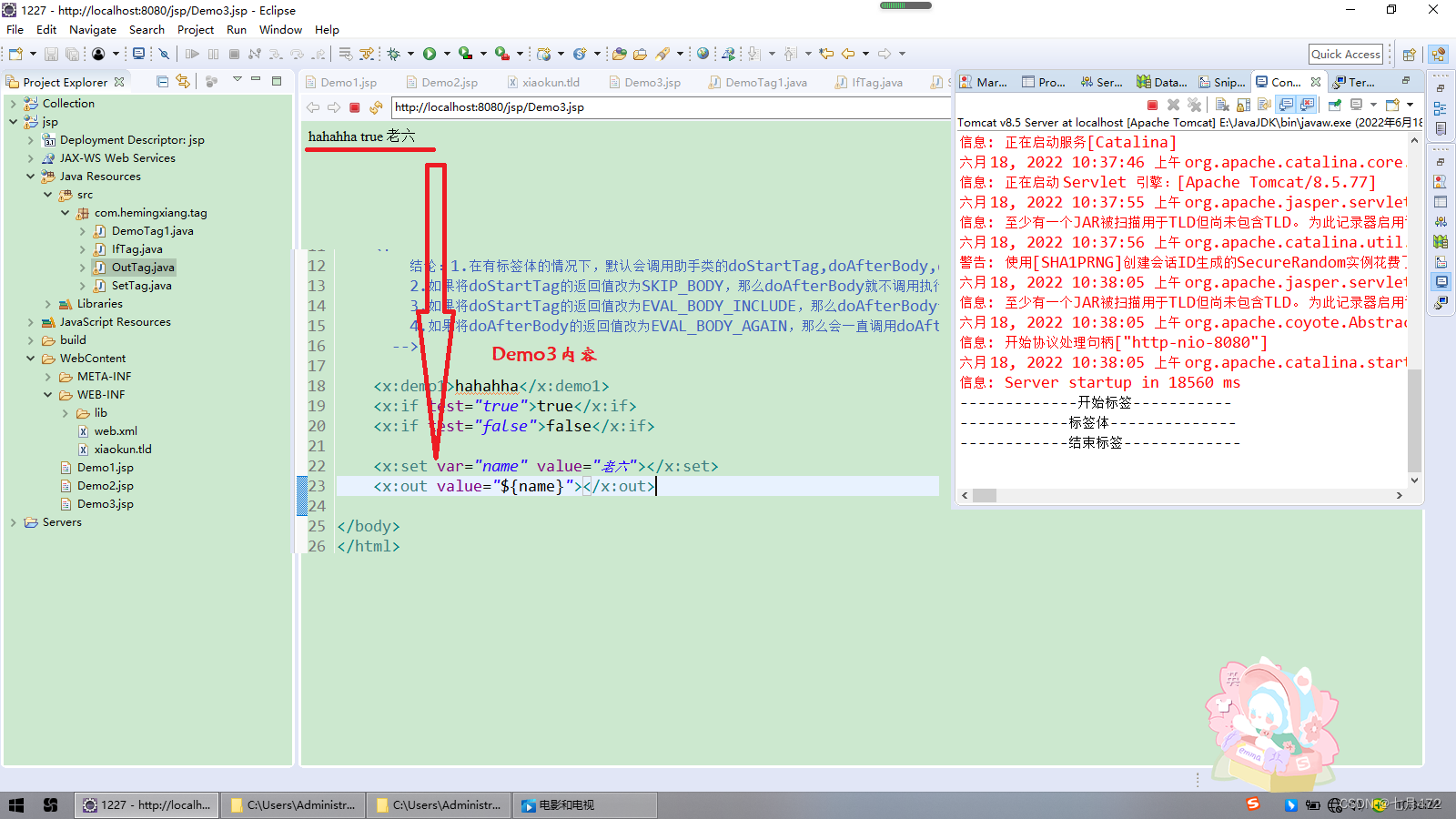
三、标签生命周期
看上面的实例得出3点结论:1.如果将doStartTag的返回值改为SKIP_BODY,那么doAfterBody就不调用执行(路线1)
2.如果将doStartTag的返回值改为EVAL_BODY_INCLUDE,那么doAfterBody会调用执行(路线2)
3.如果将doAfterBody的返回值改为EVAL_BODY_AGAIN,那么会一直调用doAfterBody,进入循环(路线3)
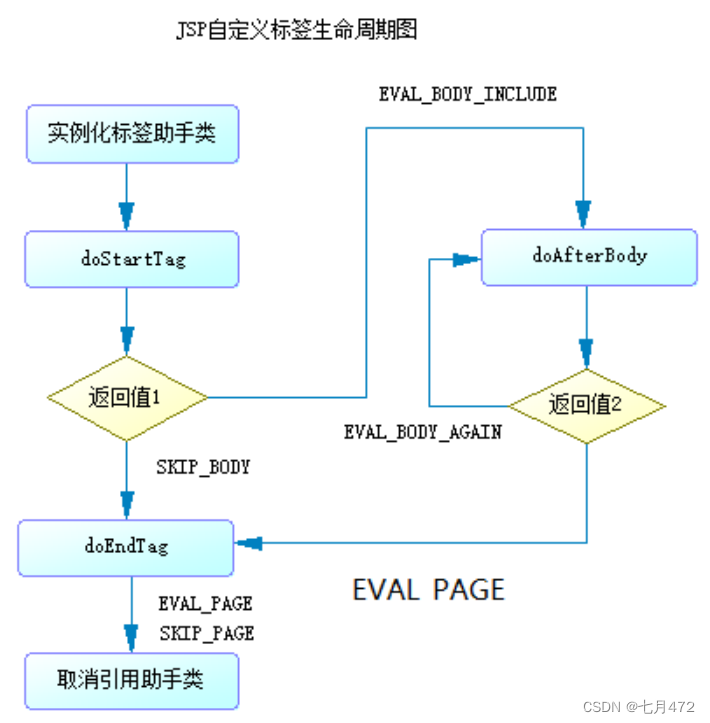
以下的返回值在实例中有用到,具体方法看实例

标签开发场景,以标注为例:

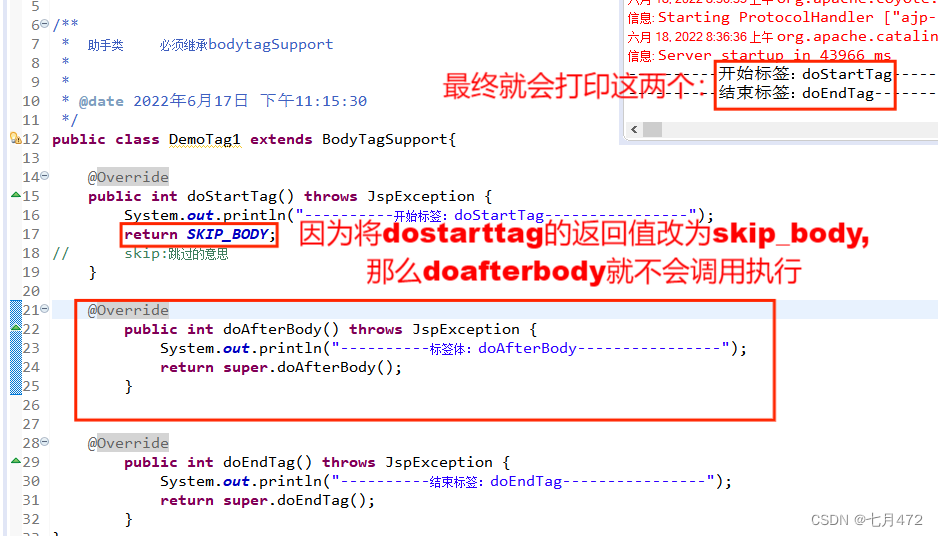
四、forEach标签&select标签
1)forEach标签:
forEach助手类:
package com.hemingxiang.tag;
/**
* forEach标签 两个属性items:list<Object> var:String
* 分析线路:
* 由第二条:eval_body_include
* 第三条:eval_body_again
* @author Administrator
*
*/
import java.util.Iterator;
import java.util.List;
import javax.servlet.jsp.JspException;
import javax.servlet.jsp.tagext.BodyTagSupport;
public class ForeachTag extends BodyTagSupport{
/**
*
*/
private static final long serialVersionUID = 1L;
private String var;
private List<Object> items;
public String getVar() {
return var;
}
public void setVar(String var) {
this.var = var;
}
public List<Object> getItems() {
return items;
}
public void setItems(List<Object> items) {
this.items = items;
}
@Override
public int doStartTag() throws JspException {
Iterator<Object> it = items.iterator();
//pageContext.setAttribute("c",items.get(0));
pageContext.setAttribute(var, it.next());
//保留迭代时指针现有位置,保留it,遍历到哪it就在哪
pageContext.setAttribute("it", it);
return EVAL_BODY_INCLUDE;
}
//要不要循环,看这个集合有没有数据
@Override
public int doAfterBody() throws JspException {
//拿到迭代器
Iterator<Object> it= (Iterator<Object>) pageContext.getAttribute("it");
//判断,如果它有下一个就进入循环
if(it.hasNext()) {
pageContext.setAttribute(var, it.next());
//保留迭代时指针现有位置,保留it,遍历到哪it就在哪
pageContext.setAttribute("it", it);
return EVAL_BODY_AGAIN;
}
else {
//没有下一步就停止
return EVAL_PAGE;
}
}
}
后在xiaokun.tld文件中添加一个foreach循环:
<tag>
<name>for</name>
<tag-class>com.hemingxiang.tag.ForeachTag</tag-class>
<body-content>JSP</body-content>
<attribute>
<name>items</name>
<required>true</required>
<rtexprvalue>true</rtexprvalue>
</attribute>
<attribute>
<name>var</name>
<required>true</required>
<rtexprvalue>false</rtexprvalue>
</attribute>
</tag>创建一个实体类,测试案例效果:
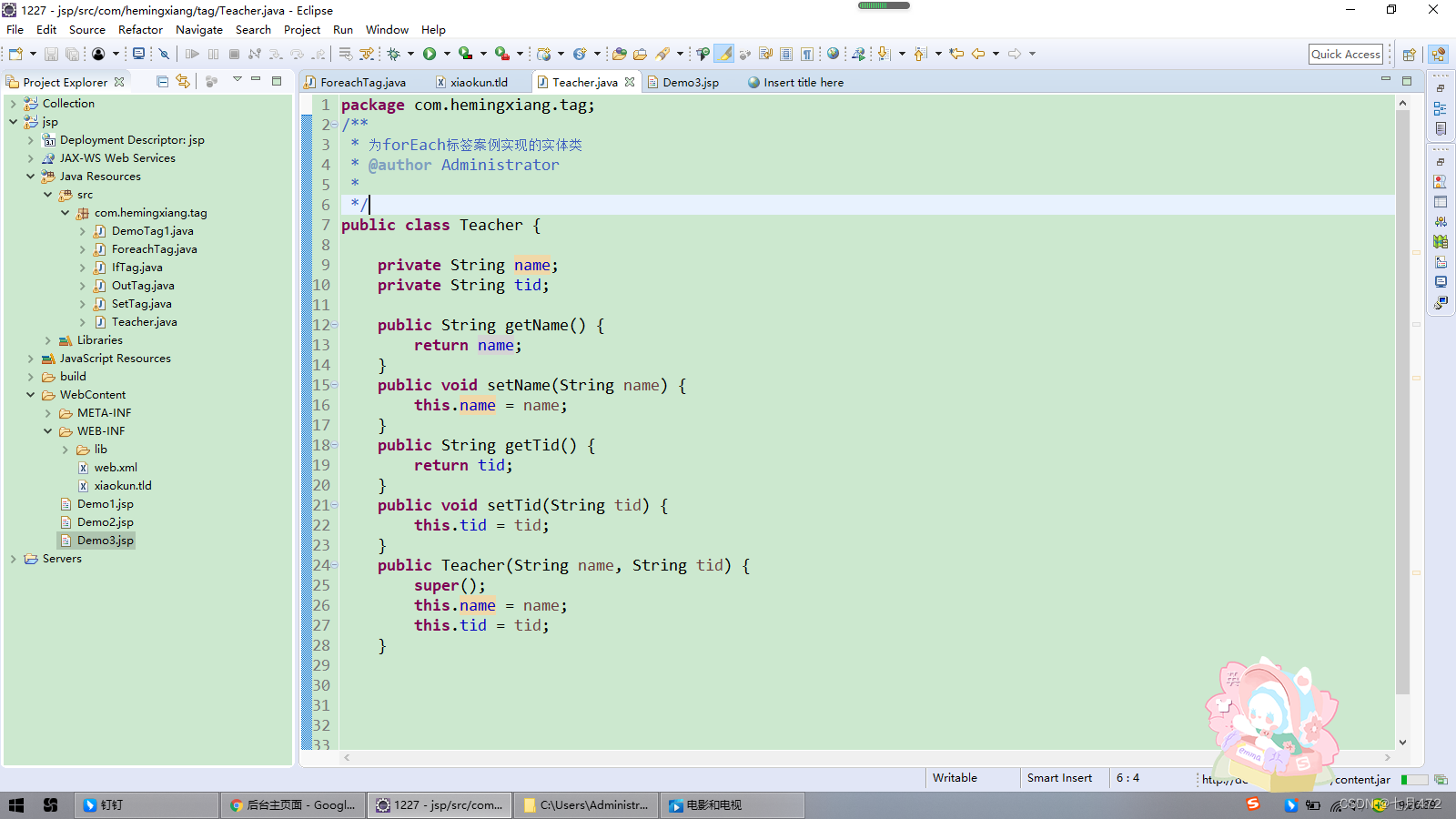
在Demo3进行代码测试:
<%
List<Teacher> list=new ArrayList<>();
list.add(new Teacher("张三","t001"));
list.add(new Teacher("王五","t002"));
list.add(new Teacher("麻子","t003"));
list.add(new Teacher("李四","t004"));
list.add(new Teacher("老六","t005"));
//加到作用域中
request.setAttribute("list", list);
%>
<x:for items="${list }" var="t">
${t.name }:${t.tid }
</x:for>输出:
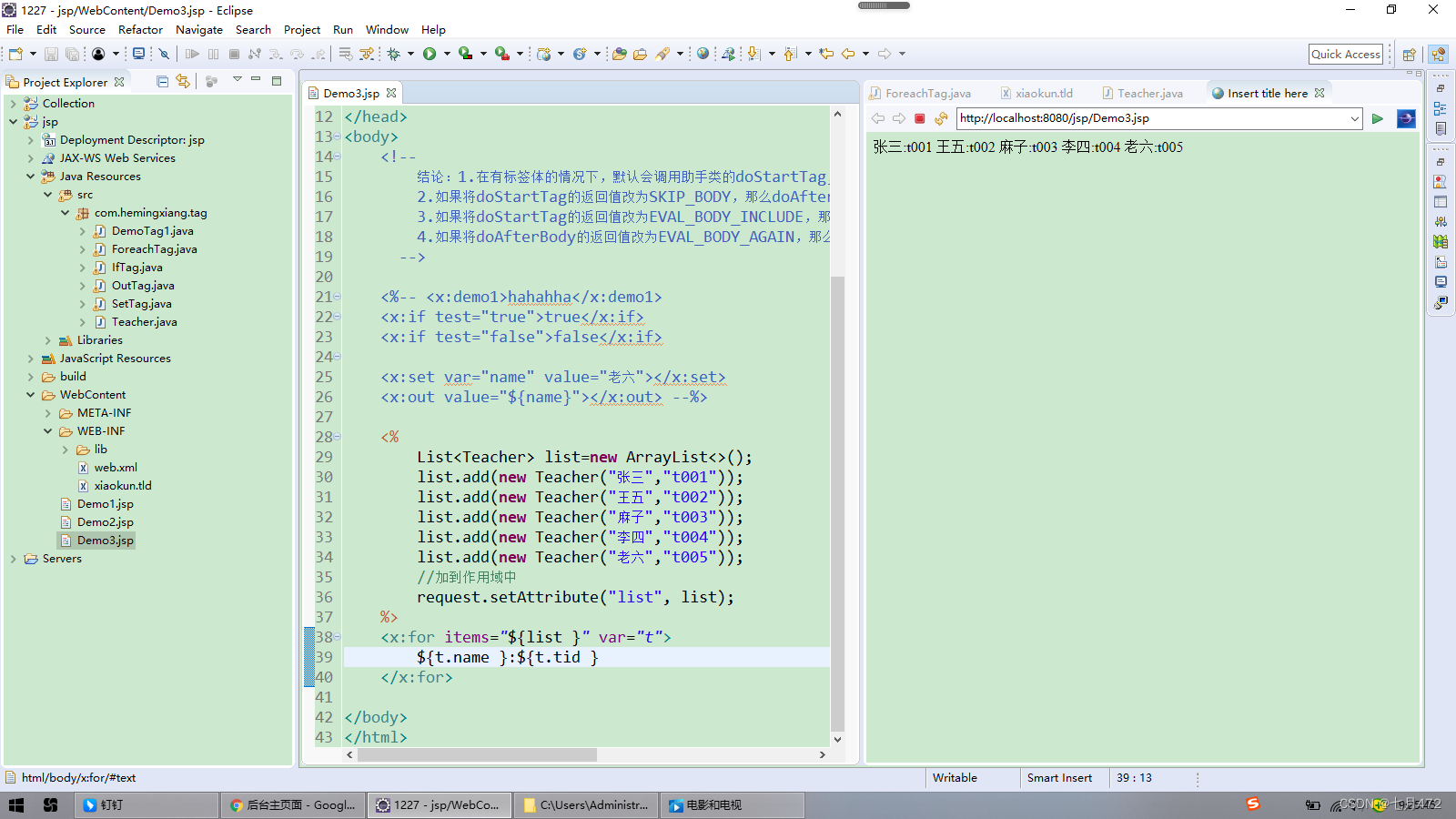
2)select标签:
🤔1.怎样省略遍历的过程
2.当做数据回显时,无需增加if判断,无需增加新的代码
selectTag助手类:
分析:
1.后台要遍历-->数据源-->items
2.需要一个对象的属性代表下拉框对应的展示内容-->textVal
3.需要一个对象的属性代表下拉框对应的value值-->textKey
4.默认的头部选项展示内容-->headerTextVal
5.默认的头部选项值-->headerTextKey
6.数据中存储的值,为了方便做数据回显-->selectedVal
7.id
8.name
9.cssStyle..
package com.hemingxiang.tag;
import java.io.IOException;
import java.lang.reflect.Field;
import java.lang.reflect.InvocationTargetException;
import java.util.List;
import javax.servlet.jsp.JspException;
import javax.servlet.jsp.JspWriter;
import javax.servlet.jsp.tagext.BodyTagSupport;
import org.apache.commons.beanutils.PropertyUtils;
/**
* 需求:1.省略遍历过程
* <c:select></select>
* 2.当做数据回显时,无需增加if判断,无需增加新的代码
* @author Administrator
*
*/
public class SelectTag extends BodyTagSupport{
private List<Object> items;
private String textVal;//option的name
private String textKey;//option的value
private String headerTextVal;
private String headerTextKey;
private String selectedVal;
private String id;
private String name;
public List<Object> getItems() {
return items;
}
public void setItems(List<Object> items) {
this.items = items;
}
public String getTextVal() {
return textVal;
}
public void setTextVal(String textVal) {
this.textVal = textVal;
}
public String getTextKey() {
return textKey;
}
public void setTextKey(String textKey) {
this.textKey = textKey;
}
public String getHeaderTextVal() {
return headerTextVal;
}
public void setHeaderTextVal(String headerTextVal) {
this.headerTextVal = headerTextVal;
}
public String getHeaderTextKey() {
return headerTextKey;
}
public void setHeaderTextKey(String headerTextKey) {
this.headerTextKey = headerTextKey;
}
public String getSelectedVal() {
return selectedVal;
}
public void setSelectedVal(String selectedVal) {
this.selectedVal = selectedVal;
}
public String getId() {
return id;
}
public void setId(String id) {
this.id = id;
}
public String getName() {
return name;
}
public void setName(String name) {
this.name = name;
}
@Override
public int doStartTag() throws JspException {
//拿到io流
JspWriter out = pageContext.getOut();
try {
try {
try {
out.print(toHTML());
} catch (InvocationTargetException e) {
// TODO Auto-generated catch block
e.printStackTrace();
} catch (NoSuchMethodException e) {
// TODO Auto-generated catch block
e.printStackTrace();
}
} catch (NoSuchFieldException e) {
// TODO Auto-generated catch block
e.printStackTrace();
} catch (SecurityException e) {
// TODO Auto-generated catch block
e.printStackTrace();
} catch (IllegalArgumentException e) {
// TODO Auto-generated catch block
e.printStackTrace();
} catch (IllegalAccessException e) {
// TODO Auto-generated catch block
e.printStackTrace();
}
} catch (IOException e) {
// TODO Auto-generated catch block
e.printStackTrace();
}
return super.doStartTag();
}
//toHTML分解
private String toHTML() throws NoSuchFieldException, SecurityException, IllegalArgumentException, IllegalAccessException, InvocationTargetException, NoSuchMethodException {
//操作一个可变得字符串
StringBuffer sb = new StringBuffer();
sb.append("<select id='"+id+"' name='"+name+"'>");
//判断
if(headerTextVal != null && !"".equals(headerTextVal)) {
sb.append("<option value='"+headerTextKey+"'>lisi</option>");
}
//下拉框的选项是在遍历中的
for (Object obj : items) {
// 反射读写属性
//拿到类类
Field textKeyField = obj.getClass().getDeclaredField(textKey);
//打开访问权限
textKeyField.setAccessible(true);
//获取obj的属性对象的值 真正下拉框展示的值
Object value = textKeyField.get(obj);
if(selectedVal!=null && !"".equals(selectedVal) && selectedVal.equals(value)) {
sb.append("<option selected value='"+value+"'>"+PropertyUtils.getProperty(obj, textVal)+"</option>");
}
else {
sb.append("<option value='"+value+"'>"+PropertyUtils.getProperty(obj, textVal)+"</option>");
}
}
sb.append("</select>");
return sb.toString();
}
}
在助手类中这样输出的代码运行结果如下:
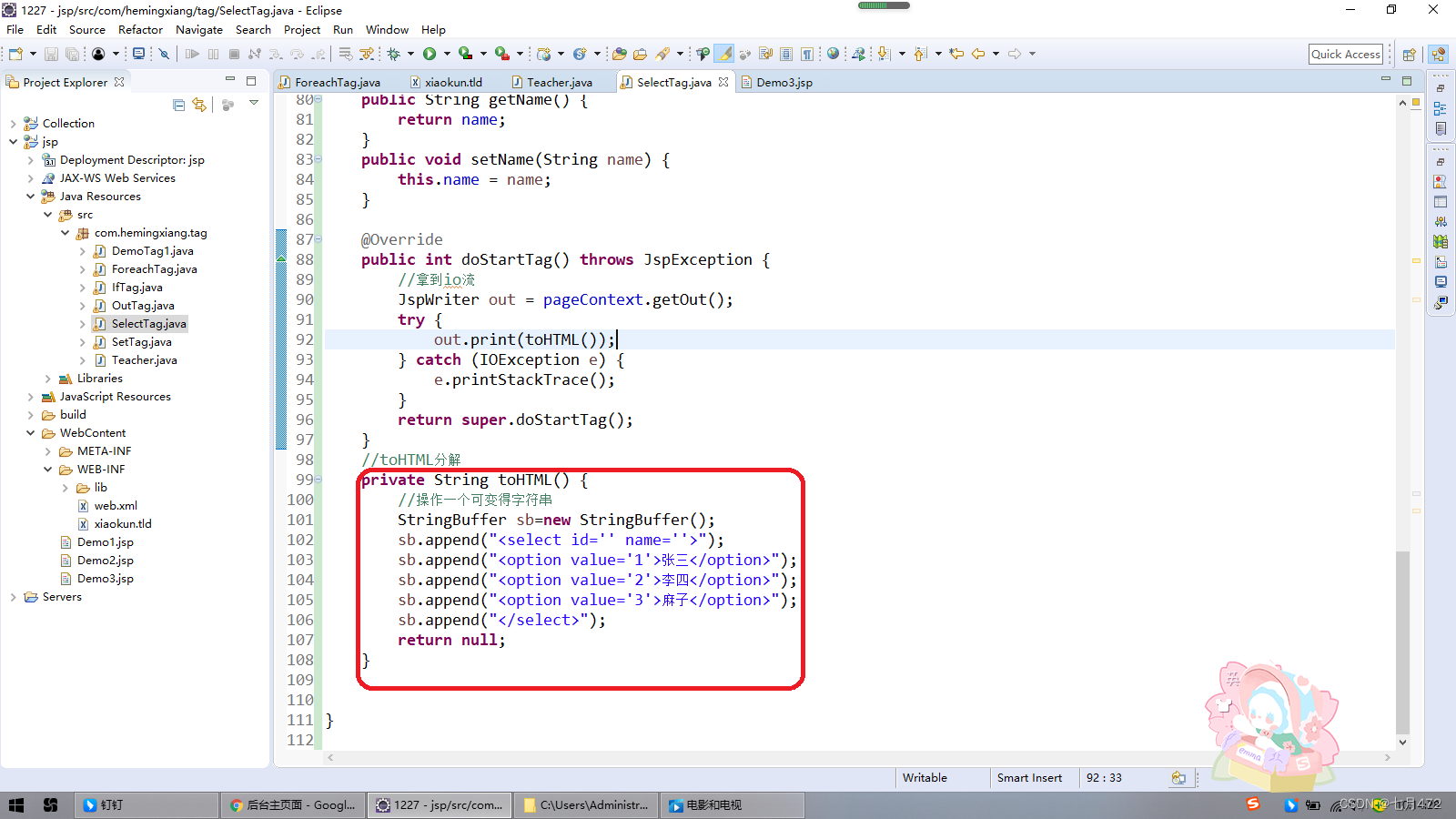
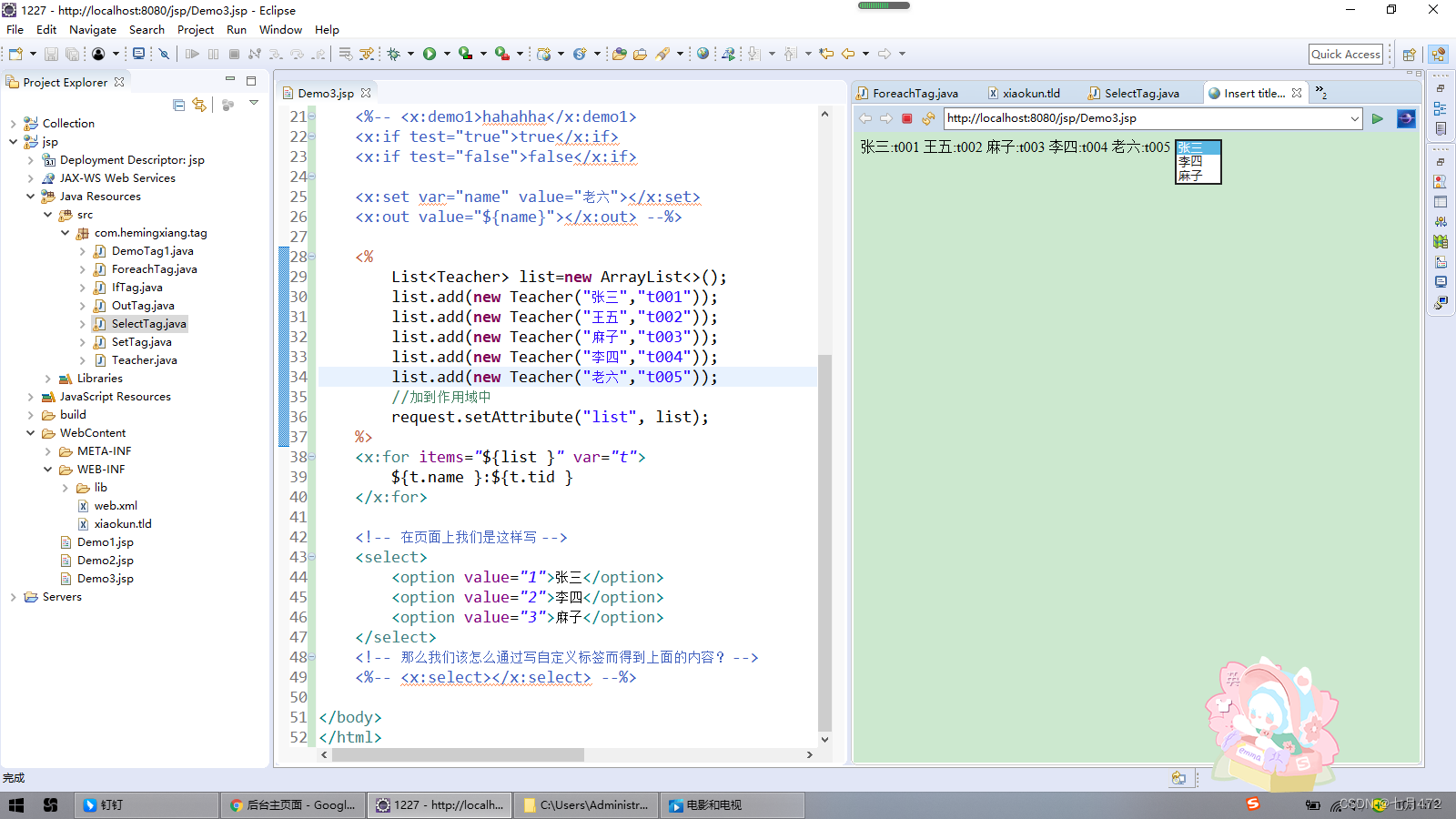
将代码进行进一步优化:
//toHTML分解
private String toHTML() throws NoSuchFieldException, SecurityException, IllegalArgumentException, IllegalAccessException, InvocationTargetException, NoSuchMethodException {
//操作一个可变得字符串
StringBuffer sb = new StringBuffer();
sb.append("<select id='"+id+"' name='"+name+"'>");
//判断
if(headerTextVal != null && !"".equals(headerTextVal)) {
sb.append("<option value='"+headerTextKey+"'>lisi</option>");
}
//下拉框的选项是在遍历中的
for (Object obj : items) {
//反射读写属性
//拿到类类
Field textKeyField = obj.getClass().getDeclaredField(textKey);
//打开访问权限
textKeyField.setAccessible(true);
//获取obj的属性对象的值 真正下拉框展示的值
Object value = textKeyField.get(obj);
if(selectedVal!=null && !"".equals(selectedVal) && selectedVal.equals(value)) {
sb.append("<option selected value='"+value+"'>"+PropertyUtils.getProperty(obj, textVal)+"</option>");
}
else {
sb.append("<option value='"+value+"'>"+PropertyUtils.getProperty(obj, textVal)+"</option>");
}
}
sb.append("</select>");
return sb.toString();
}
输出结果:
这里用到PropertyUtils,它可以进一步优化简化代码
后在xiaokun.tld文件中添加一个select标签:
<tag>
<name>select</name>
<tag-class>com.hemingxiang.tag.SelectTag</tag-class>
<body-content>JSP</body-content>
<attribute>
<name>items</name>
<required>true</required>
<rtexprvalue>true</rtexprvalue>
</attribute>
<attribute>
<name>textVal</name>
<required>true</required>
<rtexprvalue>false</rtexprvalue>
</attribute>
<attribute>
<name>textKey</name>
<required>true</required>
<rtexprvalue>false</rtexprvalue>
</attribute>
<attribute>
<name>headerTextVal</name>
<required>false</required>
<rtexprvalue>false</rtexprvalue>
</attribute>
<attribute>
<name>headerTextKey</name>
<required>false</required>
<rtexprvalue>false</rtexprvalue>
</attribute>
<attribute>
<name>selectedVal</name>
<required>false</required>
<rtexprvalue>true</rtexprvalue>
</attribute>
<attribute>
<name>id</name>
<required>false</required>
<rtexprvalue>false</rtexprvalue>
</attribute>
<attribute>
<name>name</name>
<required>false</required>
<rtexprvalue>false</rtexprvalue>
</attribute>
</tag>利用上面的list集合,测试:
<%
List<Teacher> list=new ArrayList<>();
list.add(new Teacher("张三","t001"));
list.add(new Teacher("王五","t002"));
list.add(new Teacher("麻子","t003"));
list.add(new Teacher("李四","t004"));
list.add(new Teacher("老六","t005"));
//加到作用域中
request.setAttribute("list", list);
%>
<x:for items="${list }" var="t">
${t.name }:${t.tid }
</x:for>
<!-- 在页面上我们是这样写 -->
<select>
<option value="1">张三</option>
<option value="2">李四</option>
<option value="3">麻子</option>
</select>
<!-- 那么我们该怎么通过写自定义标签而得到上面的内容? -->
<%-- <x:select></x:select> --%>
<x:select id="myf" selectedVal="t003" headerTextKey="-1" headerTextVal="==请选择==" textVal="name" items="${list }" textKey="tid"></x:select>以下为运行效果:
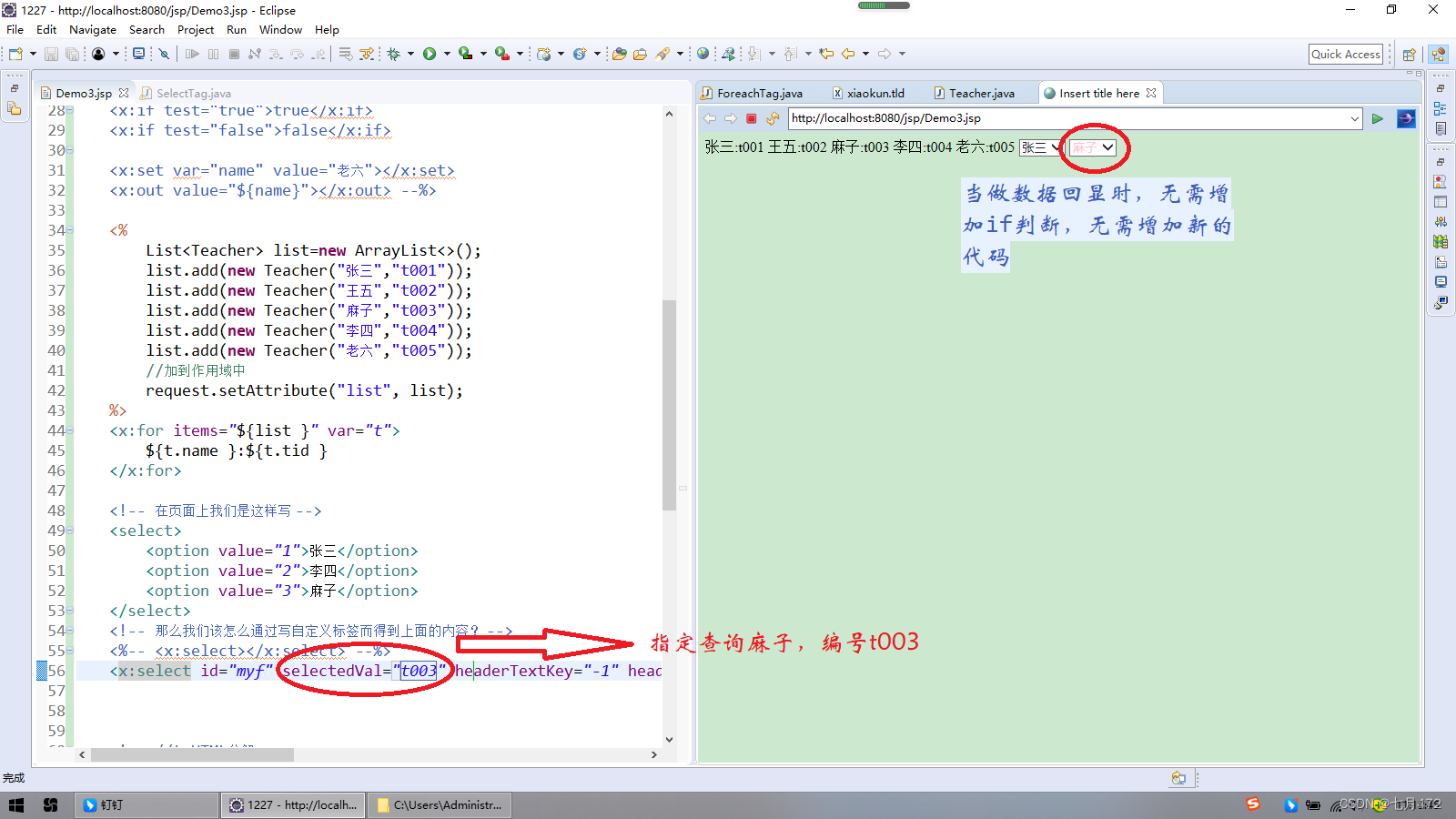








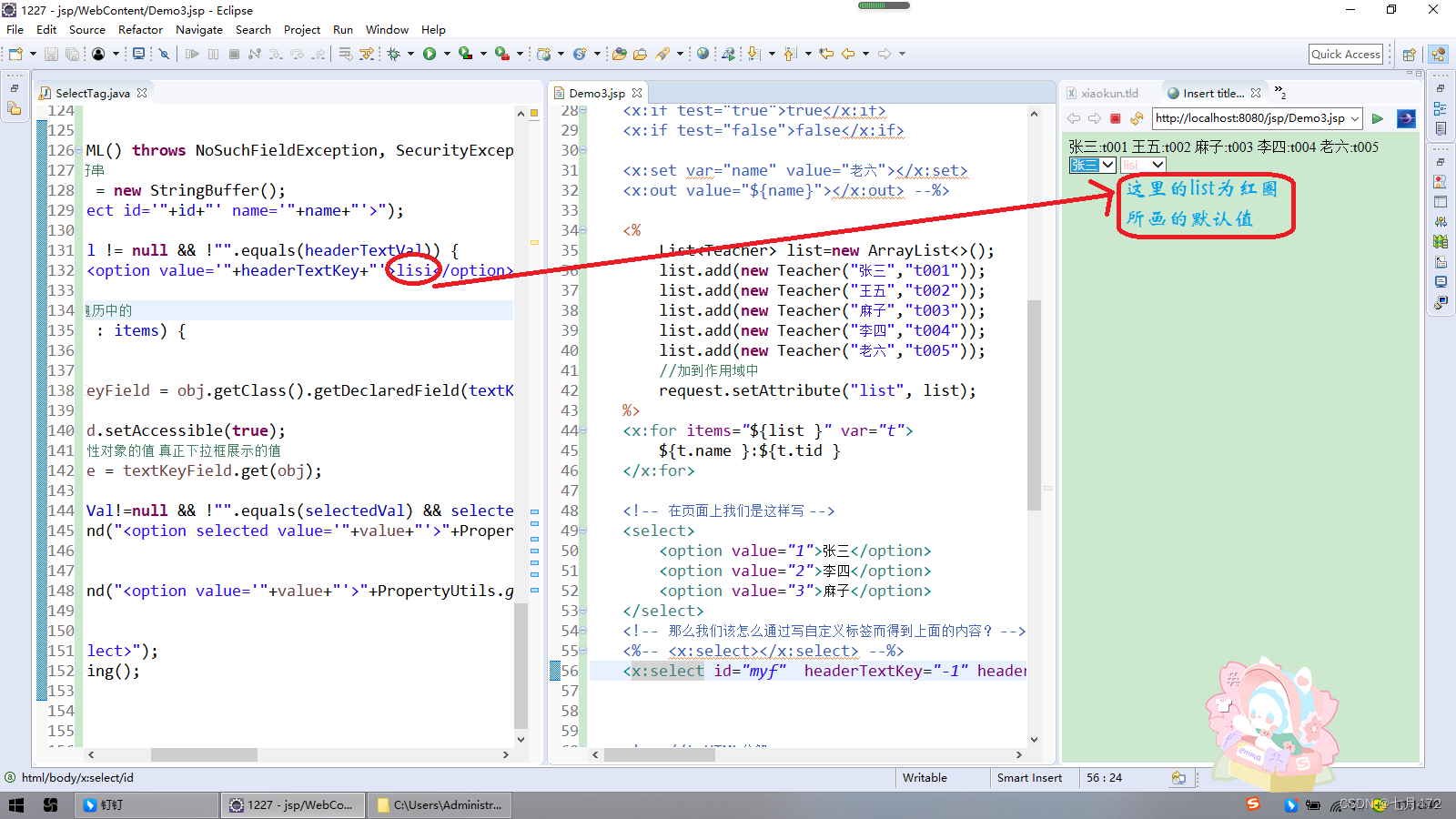
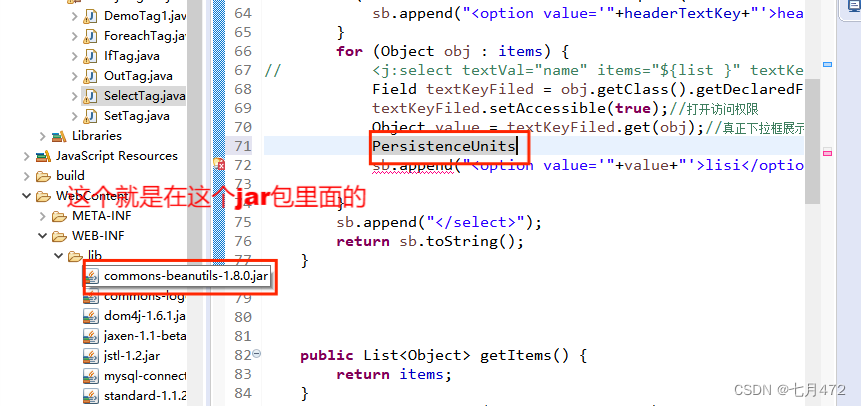














 405
405











 被折叠的 条评论
为什么被折叠?
被折叠的 条评论
为什么被折叠?








